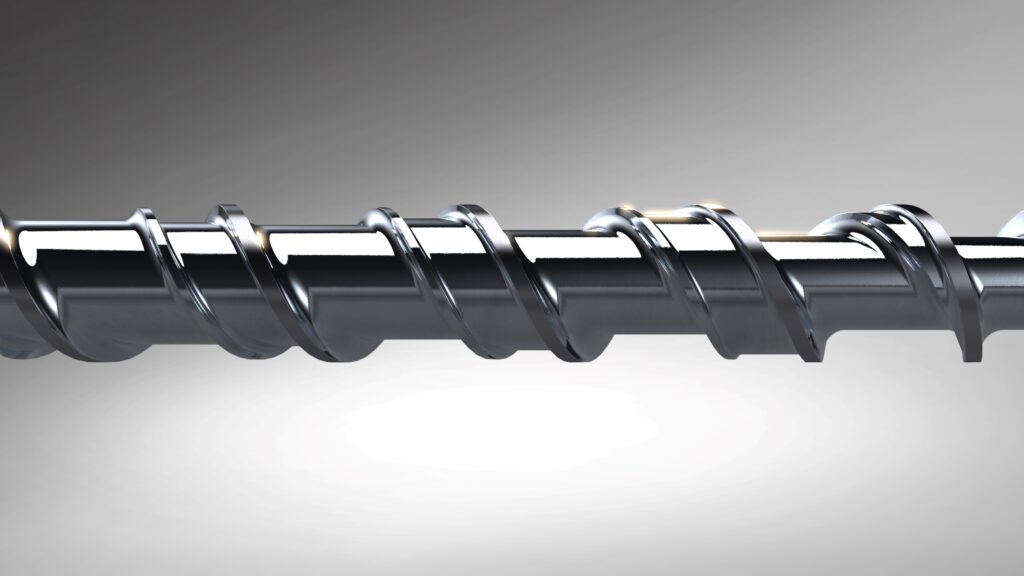In plastic manufacturing, the consistency and quality of the polymer melt are critical to product performance, durability, and aesthetics. Whether you’re producing high-precision medical devices or everyday packaging materials, maintaining a homogenous melt is non-negotiable. At the heart of this process lies an often-underappreciated component: the screw. More specifically, plastic screws, the helical workhorses of injection molding and extrusion machines, play a pivotal role in shaping material behavior under heat and shear.
This article delves into how screw design impacts plastic melt consistency and quality—highlighting key design elements, their roles in thermomechanical performance, and how engineers optimize screw configurations for specific polymers and applications.
Understanding Plastic Screws in Melt Processing
Plastic screws are central to the extrusion and injection molding process. These components perform three main functions:
- Feeding: Moving plastic pellets or powders from the hopper into the barrel.
- Melting: Applying shear and heat to transform solid polymer into a uniform melt.
- Metering/Pumping: Delivering the homogenized melt forward under controlled pressure.
Each of these functions occurs in distinct zones along the screw’s length, typically divided into three parts:
- Feed Zone: Where solid material is conveyed and pre-heated.
- Compression Zone (also called the transition or melting zone): Where the polymer is gradually compressed and melted via friction and barrel heaters.
- Metering Zone: Where the melt is homogenized and pressurized before exiting the screw.
A small variation in screw geometry—pitch, length-to-diameter (L/D) ratio, channel depth, flight width, or mixing elements—can cause significant shifts in melt consistency and quality.
Key Screw Design Features Affecting Melt Quality
1. Screw Diameter and L/D Ratio
The length-to-diameter (L/D) ratio significantly influences residence time and melting efficiency. A higher L/D ratio allows longer exposure to shear and heat, which benefits polymers requiring more time to melt. However, excessive residence time can degrade heat-sensitive materials.
A typical L/D ratio for general-purpose plastic screws is 20:1 to 24:1. High-performance or multi-stage screws may extend to 30:1 or more, especially for engineering polymers or high-output applications.
2. Compression Ratio
This ratio compares the channel depth in the feed zone to that in the metering zone. A higher compression ratio results in more shear and pressure, leading to finer homogenization. It works well for rigid materials like polycarbonate or PET.
Low compression ratios are preferred for shear-sensitive materials like PVC or EVA, reducing the risk of thermal degradation or volatile release.
3. Channel Depth and Flight Geometry
Deeper feed channels accommodate higher material throughput but may reduce back pressure, affecting melt quality. Shallower metering channels increase shear and improve mixing but can elevate melt temperature.
Flight design—including flight width, angle, and clearance—also governs how the polymer moves and mixes. Narrower flights create higher pressure and mixing, while wider flights enhance throughput but risk compromising uniformity.
Enhancing Melt Consistency with Mixing Elements
In advanced applications, standard screws are often modified or segmented with mixing elements. These devices promote distributive (physical spreading) and dispersive (breaking apart agglomerates) mixing, improving melt quality and pigment or filler distribution.
Common Designs:
- Maddock Mixer: Enhances dispersive mixing; often used in metering zones.
- Egan Mixer: Similar to Maddock but with a different shearing mechanism.
- Saxton or Spiral Mixers: Promote both distributive and dispersive effects.
- Barrier Screws: Feature a secondary flight to separate solid and melt phases, improving melting uniformity and throughput.
These features are particularly useful for applications requiring tight melt uniformity, such as fiber spinning, film production, or parts with optical clarity.
Material-Specific Screw Design Considerations
Different thermoplastics behave uniquely under shear, heat, and pressure. Tailoring screw design to the polymer in use ensures optimal melt quality:
- Polyethylene (PE): Benefits from barrier screws for improved melt separation.
- Polypropylene (PP): Requires good mixing but controlled shear; moderate compression ratios are effective.
- Polystyrene (PS): Requires high throughput and minimal shear; screws with low compression and high L/D ratios work well.
- PVC: Extremely shear-sensitive; demands screws with gentle compression and cooling zones to prevent degradation.
- Filled or Reinforced Polymers: Require screws with intensive mixing zones and robust metallurgical resistance to abrasion.
Process Implications of Poor Screw Design
A poorly matched screw design can introduce a range of processing and product defects:
- Inconsistent Melt Viscosity: Leads to surface defects, dimensional instability, and variable cycle times.
- Unmelted Particles: Result in visual blemishes or poor mechanical performance.
- Degraded Material: Due to excessive shear or residence time, producing off-odors, discoloration, or brittleness.
- Poor Color Dispersion: Causes streaking or inconsistent coloration in final parts.
- Excessive Back Pressure or Screw Slippage: Lowers throughput and stresses machine components.
Optimizing screw design is not just a technical improvement—it’s a business imperative for quality assurance and process efficiency.
Screw Design Optimization: A Systems Approach
Optimizing plastic screws for melt consistency requires considering more than just geometry. Engineers take a holistic approach, balancing:
- Material Rheology: Understanding how the polymer flows under temperature and pressure.
- Thermal Conductivity: Controlling the heat transfer rate across zones.
- Shear Sensitivity: Adjusting mixing intensity to avoid degradation.
- Throughput Requirements: Matching screw size and speed to production needs.
- Additives and Fillers: Ensuring proper dispersion and preventing buildup.
Tools such as computational fluid dynamics (CFD), melt flow simulations, and empirical testing guide this process, supported by decades of accumulated know-how in screw design and polymer science.
Emerging Trends in Screw Technology
With sustainability and high-performance materials on the rise, screw designs are evolving rapidly:
- Recycling-Optimized Screws: For post-consumer plastics, these screws must tolerate contamination, variable melt flow rates, and aggressive degassing.
- Biopolymer Processing: Requires low-shear, low-temperature designs due to thermal instability.
- High-Speed Extrusion: Demands screws that can maintain melt quality at elevated outputs.
- Modular Screw Elements: Enable flexible reconfiguration for multi-material or experimental processing.
Another trend is smart sensor integration. This enables real-time monitoring of melt pressure, temperature, and viscosity, further enhancing process control.
Screws Are the Unsung Heroes of Plastic Processing
While often overlooked, screw design is foundational to melt consistency and product quality in plastic manufacturing. Every detail—from the L/D ratio to flight depth to mixing elements—plays a role in how raw polymer is transformed into a final product.
Investing in well-designed plastic screws tailored to material and process parameters can reduce waste, improve output, and ensure product consistency across production runs. Whether you’re troubleshooting melt inconsistencies or designing a new production line, remember: the screw is more than a conveyor—it’s a precision-engineered tool that shapes the very foundation of your product’s success.






